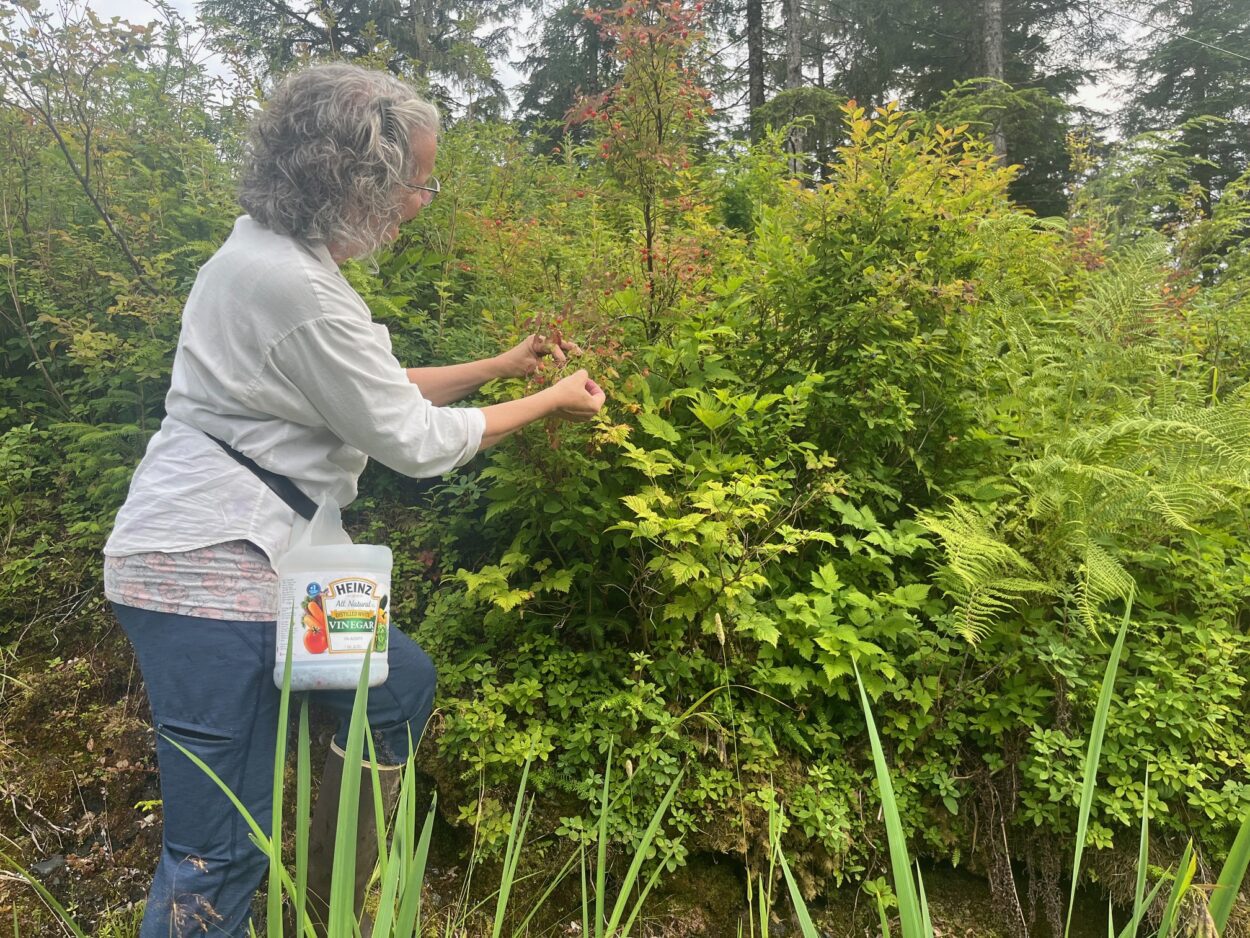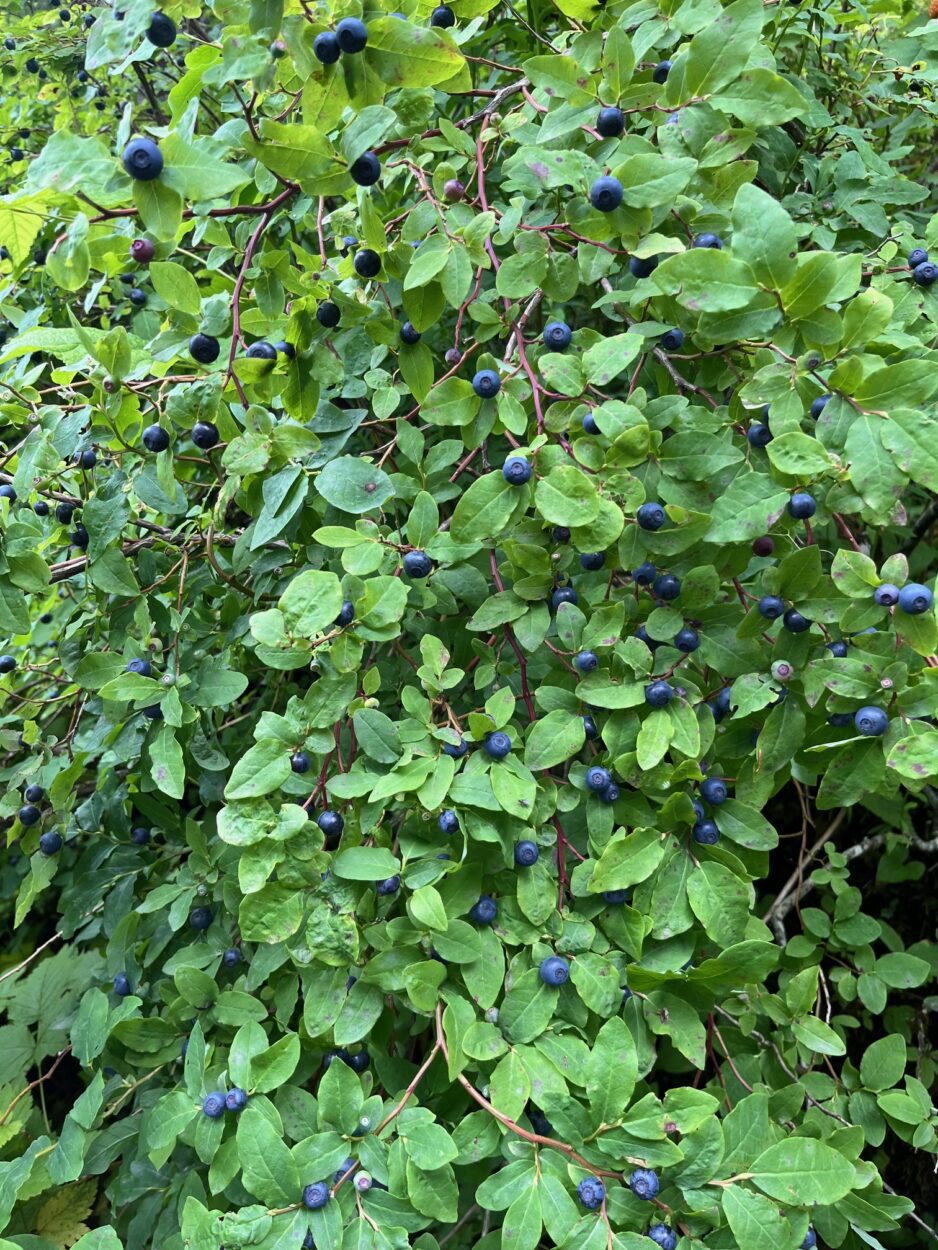
Listen here:
Mary Ellen Anderson dropped blueberries one by one into into an old plastic vinegar jug, the top cut off and fastened around her waist with a leather belt passed through the handle. We were below her house in a sprawling hillside tangle of blueberry and huckleberry bushes. She told me she likes the feel of the berries between her fingers.
“I like to pick clean, so when I’m done, I don’t end up with a whole bunch of, you know, branches and whatnot,” she said. “And this way too, I can kind of analyze as I go, and only pick the things that are like – here’s one that’s got worms, obviously soft, and it’s got holes in it.”
She bent a branch and showed me the berry.
“So I’m not going to pick that one. I’ll just leave it.”
Anderson cultivates the patch. She cuts rough trails into the heart of it, and prunes competing vegetation. She’s been picking blueberries and huckleberries since she got to Petersburg more than three decades ago. And this year, she said, is a very good year. The region’s highbush variety – oval-leaf blueberries and black huckleberries – are absolutely everywhere.
So, why is it so good? Anderson had some ideas.
“If you get the right combination, and I don’t know what it is, like, I think the sun makes them sweeter and the rain makes them bigger,” she said. “That’s my theory. I don’t know if that’s true.”
It turns out she’s right, but there’s more to it than that.
Cool days in the early spring are important, said Joni Johnson, a biologist with the U.S. Forest Service. They trigger blueberries to bud. But anything below 32 degrees spells doom for the budding blossoms. Johnson said this year, the temperatures were just right.
“We didn’t have crazy freezes after snow melt or in early April, late March, if I’m remembering right,” she said. “So kind of nice warming temperatures, no extreme freezes, it’ll damage the flower buds.”
Once the budding process has started, those blossoms need sunshine to grow. And the more sunshine, the more the blossoms can be pollinated by bees and other insects. Johnson said this year, warm temperatures in mid April and early May were perfectly timed.
Once the blossoms have fully bloomed and the pollination process is complete, rain is important.
“Our blueberries are shallow rooted blueberries,” she said. “And so soil moisture is a real deal for them. And so if there’s a super long dry spell, they’ll abort berries.”
And this year, Southeast Alaska got consistent rain in late May and early June.
Johnson said when it’s drier, there are usually fewer, smaller berries, but the determined picker can still find them by looking in places without great drainage like forested wetlands and along streambeds.
According to Johnson, there are ways to improve a personal blueberry patch.
“They have shallow roots, so a good organic layer that helps retain moisture, and even ground cover, whether you’re cultivating mosses, or something like that on the surface,” she said.
She said pruning the blueberry bushes will stimulate production, something deer do naturally when they feed on the bushes during colder months. And she says they thrive in acidic, nutrient poor soil, so no need to fertilize.

Back at the blueberry patch, Mary Ellen Anderson was almost ready to call it quits for the day. Even though she’d been carefully inspecting her berries for worms, she said she planned to soak them in saltwater.
“They don’t like the salt, of course,” she said. “So they come screaming out of the berries and float around the top looking for a way out of that.”
It turns out those critters aren’t technically worms, according to Alexandria Wenninger, an entomologist with the University of Alaska Fairbanks. She said in Southeast Alaska, they’re likely a mix of caterpillars, maggots, and fly larvae.
Either way, Anderson isn’t particularly bothered by them. She said she just picks them out and squishes them between her fingers.
Anderson ended up with a few cups of berries, but she said she’ll be picking more.
“I make lots of blueberry jam and I’m down to two jars,” she said. “So it’s getting to be an emergency.”
She said it takes eight cups to make a batch of jam.











